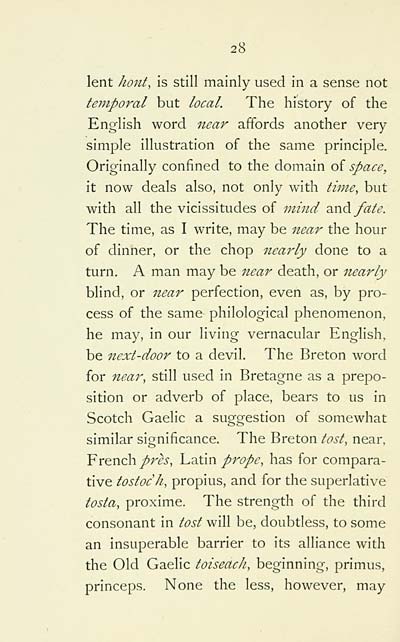Blair Collection > Vestigia celtica
(32)
Download files
Complete book:
Individual page:
Thumbnail gallery: Grid view | List view

28
lent hont, is still mainly used in a sense not
temporal but local. The history of the
English word near affords another very
simple illustration of the same principle.
Originally confined to the domain of space^
it now deals also, not only with time, but
with all the vicissitudes of mind 3.nd /ate.
The time, as I write, may be 7iear the hour
of dinner, or the chop nearly done to a
turn. A man may be near death, or nearly
blind, or near perfection, even as, by pro-
cess of the same philological phenomenon,
he may, in our living vernacular English,
be next-door to a devil. The Breton word
for near, still used in Bretagne as a prepo-
sition or adverb of place, bears to us in
Scotch Gaelic a suggestion of somewhat
similar significance. The Breton tost, near,
French pres, Latin prope, has for compara-
tive tostoch, propius, and for the superlative
tosta, proxime. The strength of the third
consonant in tost will be, doubtless, to some
an insuperable barrier to its alliance with
the Old Gaelic toiseach, beginning, primus,
princeps. None the less, however, may
lent hont, is still mainly used in a sense not
temporal but local. The history of the
English word near affords another very
simple illustration of the same principle.
Originally confined to the domain of space^
it now deals also, not only with time, but
with all the vicissitudes of mind 3.nd /ate.
The time, as I write, may be 7iear the hour
of dinner, or the chop nearly done to a
turn. A man may be near death, or nearly
blind, or near perfection, even as, by pro-
cess of the same philological phenomenon,
he may, in our living vernacular English,
be next-door to a devil. The Breton word
for near, still used in Bretagne as a prepo-
sition or adverb of place, bears to us in
Scotch Gaelic a suggestion of somewhat
similar significance. The Breton tost, near,
French pres, Latin prope, has for compara-
tive tostoch, propius, and for the superlative
tosta, proxime. The strength of the third
consonant in tost will be, doubtless, to some
an insuperable barrier to its alliance with
the Old Gaelic toiseach, beginning, primus,
princeps. None the less, however, may
Set display mode to: Large image | Transcription
Images and transcriptions on this page, including medium image downloads, may be used under the Creative Commons Attribution 4.0 International Licence unless otherwise stated. ![]()
| Early Gaelic Book Collections > Blair Collection > Vestigia celtica > (32) |
|---|
| Permanent URL | https://digital.nls.uk/75800767 |
|---|
| Description | Celtic footprints in philology ethics and religion. |
|---|---|
| Shelfmark | Blair.1 |
| Additional NLS resources: | |
| Attribution and copyright: |
|
| Description | A selection of books from a collection of more than 500 titles, mostly on religious and literary topics. Also includes some material dealing with other Celtic languages and societies. Collection created towards the end of the 19th century by Lady Evelyn Stewart Murray. |
|---|
| Description | Selected items from five 'Special and Named Printed Collections'. Includes books in Gaelic and other Celtic languages, works about the Gaels, their languages, literature, culture and history. |
|---|

